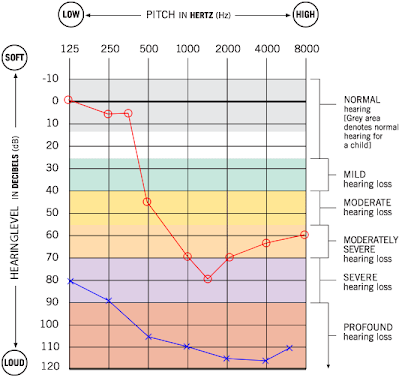When I was in graduate school, I remember studying audiograms (hearing assessment results, plotted on a graph) and thinking, "Why in the world do I need to know how to read an audiogram?" "I am here to teach, not be an audiologist, what does it matter?"
Well, I am thankful that I can quickly glance at a student's audiogram and get a general idea of what type of hearing loss he or she may have. I look at audiograms frequently for my job as an itinerant teacher. I am usually asked to explain or interpret the results from audiograms several times a week.
I was at a meeting recently where we talked to a high school student about advocating for himself in one of his large class rooms. At first, the student did most of the talking, I listened and wrote down his concerns and questions.
During the meeting, an administrative asked him, "Which is your better ear? Then maybe you can sit somewhere in the room where your better ear is near the sound source."
The student looked confused and became quiet as he pondered this question. He answered, "Hmm, I am not sure. I think I hear about the same in both ears." Then he asked, "Where is my audiogram?"
The well meaning administrator responded, "No, it should not matter what the audiogram says or what your audiologist says, which ear do you think is your better ear?"
As my student sat there squirming, I found his audiogram and explained to the administrator, "According to his audiogram, he has very similar hearing in both ears. They are almost identical really." I showed her the charts. I continued, "This student and I discussed this before and he understood at the time that it would be hard for him to tell others which is his better ear. As you can see, this would be difficult to do."
I asked the student, "This is why you asked for your audiogram, right? You wanted to show us how you hear?"
The student nodded, looked at the audiogram and was able to elaborate more on how he hears. He said, "It's kind of hard to explain, but looking at this helps."
Below is an example of how a somewhat similar hearing loss in both ears would look like:
An example of what very different hearing in the left and right ear would look like. Here you can tell that the right ear is the better ear:
(e
Related post: Read an Audiogram - How to Do it
Well, I am thankful that I can quickly glance at a student's audiogram and get a general idea of what type of hearing loss he or she may have. I look at audiograms frequently for my job as an itinerant teacher. I am usually asked to explain or interpret the results from audiograms several times a week.
I was at a meeting recently where we talked to a high school student about advocating for himself in one of his large class rooms. At first, the student did most of the talking, I listened and wrote down his concerns and questions.
During the meeting, an administrative asked him, "Which is your better ear? Then maybe you can sit somewhere in the room where your better ear is near the sound source."
The student looked confused and became quiet as he pondered this question. He answered, "Hmm, I am not sure. I think I hear about the same in both ears." Then he asked, "Where is my audiogram?"
The well meaning administrator responded, "No, it should not matter what the audiogram says or what your audiologist says, which ear do you think is your better ear?"
As my student sat there squirming, I found his audiogram and explained to the administrator, "According to his audiogram, he has very similar hearing in both ears. They are almost identical really." I showed her the charts. I continued, "This student and I discussed this before and he understood at the time that it would be hard for him to tell others which is his better ear. As you can see, this would be difficult to do."
I asked the student, "This is why you asked for your audiogram, right? You wanted to show us how you hear?"
The student nodded, looked at the audiogram and was able to elaborate more on how he hears. He said, "It's kind of hard to explain, but looking at this helps."
Below is an example of how a somewhat similar hearing loss in both ears would look like:
 |
| Made from hearingaidknow.com's Audiogram Creator |
An example of what very different hearing in the left and right ear would look like. Here you can tell that the right ear is the better ear:
 |
| Made from hearingaidknow.com's Audiogram Creator |
(e
Related post: Read an Audiogram - How to Do it
Neat.
ReplyDelete